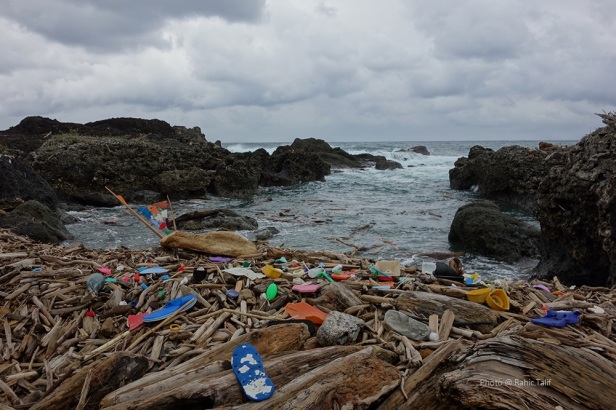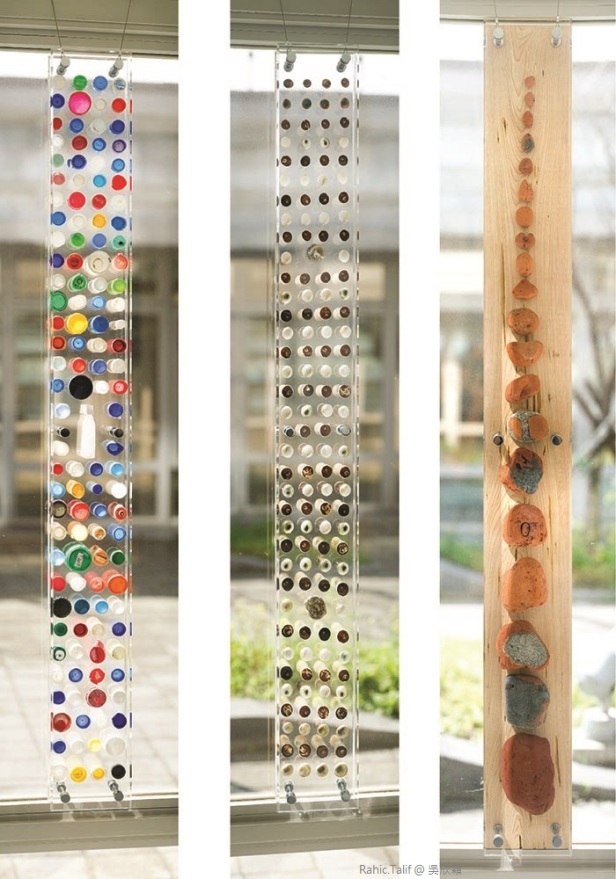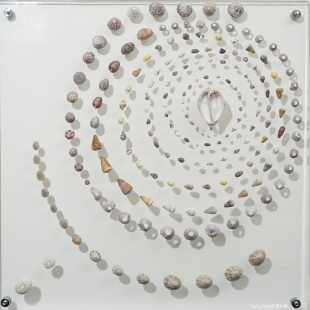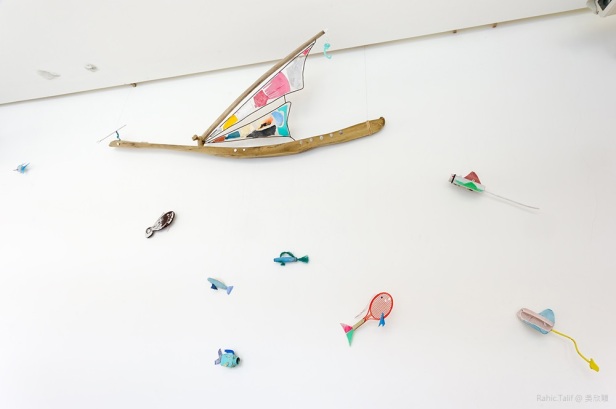那些被遺棄的,海洋接納了
Those that have been abandoned are accepted by the ocean.
2014年1月國立海洋科技博物館主題館正式營運開幕,特邀請藝術家拉黑子‧達立夫策畫製作一系列以海洋文化為主軸所衍生的環境教育藝術作品。世居於花蓮大港口部落的拉黑子‧達立夫說,他們的傳統生活有百分之七十來自於海洋豐盛的給予,傳統的語言中其實並沒有垃圾這個詞,現今阿美族語用來指稱垃圾的Lakaw這個字,在過去所指的不過就是野草、落葉這些一燒就會消失的東西,真要說最麻煩的Lakaw大概就是那些燒不掉的貝殼了。然而以往海邊常見的月光螺如今卻已然被眾多的瓶蓋所取代、被拖鞋取代、被塑膠片取代,這些曾經被人們珍惜的穿著、使用著的東西如今無主殘敗的堆積在岸邊,造成海岸的傷害。
四組作品中絕大部分的材料正是這些由創作者每日行走於家鄉太平洋邊緣所撿拾的物件,拉黑子‧達立夫在過程中持續提問,他們的主人呢?他們看到了什麼?如果這些廢棄物有意志,他們會想去哪裡?會想要怎麼繼續他們的生命?創作者將他所拾回的物件重新組合,讓這些已然被廢棄的物件,呈現出一種視覺上的美感與認知上的違和感,透過他們的眼睛,帶領觀者用不同的角度觀看,也藉此誘發觀者自問「我看到的太平洋之美,是什麼美?」
The Main Hall of National Museum of Marine Science and Technology opened in January 2014. The Museum invited Rahic.Talif to plan and create a serial of artworks for environmental education that themed on the culture of ocean. Rahic.Talif’s family has been living in the Makotaay tribe in HualienCountry for generations. According to Rahic.Talif, with their traditional lifestyle, about 70 % of daily needs are supplied by the ocean. There is no such term as “garbage” in their traditional language. The term “Lakaw” in Amis is used to refers to garbage nowadays, but it originally meant weeds and leaves—things that burnable. The most troublesome “Lakaw” are shells, for they are hard to burn down. However, while we used to see shells on the seashore, nowadays they have been replaced by lots of plastic caps, slippers and shreds. What had once been carefully wore and used are now discarded, piling up disorderly by the seashore, causing damage to the ocean.
The four sets of artworks are largely composed of materials Rahic.Talif picks up in his daily walk along the shore of the Pacific Ocean in his hometown. The questions Rahic.Talif keeps asking are: where are their owners? What did they see? If those discarded materials have their own will, where would they go? How they want to continue “living”? Rahic.Talif reconstructed those materials into artworks that show the “inconsistency” in visual, aesthetical and cognitional aspects. Through the eyes of those discarded materials, he intends to display different angles for the audience to look and to ask themselves this question: What kind of “beauty” do I see in the ocean?
創作自述
「以前,我們無法,也不會那麼容易的靠近她,
當人們走到的時候,
那個岩岸裝滿了好多好多的東西,
貝類的、魚類的、海菜的……
而現在,走過去是那樣快速,
海洋所裝滿的,卻都是人們遺棄的那些。」
「太平洋之美」的展覽中並置了太平洋沿岸所展現的衝突意象:自然與人為、珍惜與遺棄,以「美」之名,揭示出海島上的人們不管是對漁獲的渴求或是對自然景觀的心靈需要,都在面對太平洋豐盛的給予之時呈顯出太過輕易的態度。
在過去,我們的傳統中生活有百分之七十來自於海洋豐盛的給予,傳統的語言中其實並沒有垃圾這個詞,現今阿美族語用來指稱垃圾的Lakaw這個字,在過去所指的不過就是野草、落葉這些一燒就會消失的東西,真要說最麻煩的Lakaw大概就是那些燒不掉的貝殼。然而以往海邊常見的月光螺如今卻已然被眾多的瓶蓋所取代、被拖鞋取代、被塑膠片取代,這些曾經被人們珍惜的穿著、使用著的東西如今無主殘敗的堆積在岸邊,造成海岸的傷害。傳統的辭彙在此,成了一種對於人類演化進程中過去與現在、文明與衰敗之間的辯證。
這些廢棄物消失在原本的生活場域轉而在岸邊堆積的不堪景象,與太平洋壯闊的風光看似對立卻又不得不彼此依存。它們破碎的銳角劃破時空預言式的顯露對未來處境的侵蝕,卻又因長期在風浪中滾動、圓滑、褪色而擬態出一種近似於超越衝突的妥協,然而這樣的偽裝卻在抽撿過程中隨即放射出強烈的訊息,控訴著曾經揚棄他們的文明,以及正在被消耗殆盡的歷史與環境。
世居於東海岸,在太平洋沿岸數百次來回行走的過程中,常任這些破碎的人為製品占滿我的雙手與背包,幾乎成了一種強迫性的撿拾癖,我總是對著我的雙手發出質疑,又在行走中回復清明。歷經細數不清的情緒輪迴後,每一次的彎腰突然都轉換成一種近乎極喜的熱情,撿拾這個動作如同對自我的沖刷,逐步內生出一種超越美感、很純粹的精神享受。
「美」的概念同時也來自於,這些海廢大多曾是標示著某個人類進展階段的重要發明,或者曾是物主透過自身審美經驗而挑選出來的物件,卻在隨時光流動的過程中因破舊或者移情而遭遇淘汰。我手上這些已然不堪的物件,從擁有到放棄對照海浪數億年如常的沖刷或者只是一瞬,然而物件卻承繼著原生的主體性,在漂流過程中持續存在,記錄著人們的思想與經驗,揣懷著一種生命仍有機會不同的執著與潛在能量。
我想像這是一種為文明的拾荒的勞動行為,在人類集體漠視的意志融混過程中,透過撿拾的動作同步拾回那個被遺忘的源頭,試圖挽回衰亡宿命,逆向追溯漂泊旅途,從最混濁的區域走向猶如被掏洗過後的澄澈,將這些生活的餘燼重新組合或者裝禎在不同的容器裡,表揚式的放在觀者的眼前,創造出一個得以冥想與靜默的對話空間,在那裡,我們不再從現實的輕率中逃逸,而是真誠的直視彼此。
Statement
“In the past, we can’t get close to her—nor was it easy.
When some people did walk up to her,
They found so many things on the rocky shore,
Such as seashells, fishes, seaweeds, and so on…
Although nowadays getting there is so fast and easy,
It turns out the ocean is filled with things discarded by people.”
In this exhibition, contradictory images of the Pacific coast are juxtaposed: the natural and the artificial, the cherished and discarded. In the name of “beauty”, I expose, both in people’s desire for fishery harvesting and spiritual need for the natural landscape, the taking-for-granted attitude they apply toward the abundant resources they find in the Pacific Ocean.
In the past, by living in traditional manners, about 70 % of our daily needs were taken cared of by abundant resources in the ocean. There is no such term as “garbage” in their traditional language. The term “Lakaw” in Pangcah is used to refers to garbage nowadays, but it originally meant weeds and leaves—things that burnable. The most troublesome “Lakaw” are shells, for they are hard to burn down. However, while we used to see shells on the seashore, nowadays they have been replaced by lots of plastic caps, slippers and shreds. What had once been carefully worn and used are now discarded, piling up disorderly by the seashore, causing damage to the ocean. Here, the term in our traditional language became the dialectic between the past and present, civilization and declination in the evolution process of human beings.
The deplorable image in which discarded wastes that had disappeared from the arena of people’s daily life were found on the coast, piling up, seems contradictive to yet inseparable from the magnificent landscape of the Pacific Ocean. Sharp broken edges of the discarded wastes cut across time and space, prophetically reveal a future that has been eroded, while at the same time mimicked a kind of compromise that can almost go beyond the contradiction as a result of being rolled, smoothed and faded in the wind for a long time. However, such mimicry sends strong messages to us as soon as we pick the waste up–they accuse the civilization of abandoning them, while pleading for the history and environment that have been gradually worn out.
My family has been living in the east coast of Taiwan for generations, and I’ve walked hundreds of times along the coastline of Pacific Ocean. In my walks, I often fill my hands and backpack with these broken man-made products, almost like having a compulsion to collect. I always question my hands, and regain my sanity later in the walk. I’ve lost count of how many times I’ve been through such emotional cycle, but the time finally came when every time I bend down to pick up things, my heart was filled with passion boarding on ecstasy. The movement of picking up became a purification of myself and developed from inside of me into a spiritual enjoyment that is pure and goes beyond aesthetic experiences.
The idea of “beauty” also comes from the fact that most of the wastes in the sea were important inventions in certain stage of human development, or had been something picked up carefully by the original owner out of his or her own aesthetic experiences, but were abandoned when they got old or were no longer considered beautiful as time went by. The things in deplorable condition in my hands have been owned and given up, and were washed up, even just for a second, by the waves that have been there for billions of years. These things inherited the original subjectivity that was given to them in the first place, which remains there while they drift. They are the record of people’s thoughts and experiences, embodying the persistency and potential energy that give life a second chance.
To me, it is a movement of picking up wastes for the civilization. In a process people collectively ignored, where people’s will is dissolving, through the movement of collecting I also try to collect the origin that has been forgotten, to defy the doom that led us to destruction, to trace against the flow in my trip of drifting, to walk from the foulest zone to the purification as if being thoroughly purged. I recompose these embers of life or frame them in different containers for them to be displayed praisingly in front of the audience to create a space of conversation allowing for meditation and silence. In such space, we no longer evade the rashness in real life, and instead, we look right into each other’s eyes honestly.
—– 作品圖錄 Plates —–
Limo o tan 珍惜
過去,那個魚網裝的,
是那樣的浪費,
竟然還可以被挑選。
如今,這個魚網依舊滿載,
裡頭裝的卻是那些已經無所棲身的炫麗碎片,
此後,我們還有那清澈的海水可以選擇嗎?
Limo o tan / Cherish
In the past, those being captured in the fishnet
Were so abundant,
We can even choose what we want or not.
Today, the fishnet is still full,
What have been captured, however,
are gaudy fragments that have no place to go,
Could we ever again have the clear seawater where we can choose something from?

媒 材│海岸廢棄物:塑膠、保麗龍、漂流木等
Material│Wastes on the shore:Plastic, Styrofoam, Driftwood, etc.
350x150x150(cm)
Kinaila 擁有過的
那些人們遺棄的,如今都被海洋接納了,
海水不停的觸摸著它,珍惜著它;
可是那些曾經用來鎖住乾淨飲水的蓋子
來到了海上,也能保護住我們的海洋嗎?
為什麼那些過去養活我們的,現在漸漸消失了,
在過度的取得,與太輕易的放棄之間,
我們是不是還能記得老祖先用toko提醒我們的,
要用自己的大便,餵養自己、茁壯自己。
Kinaila / What we once had
What has been abandoned by people are accepted by the ocean.
The seawater keeps touching it, cherishing it;
However, the bottle caps that had been used as the lock to keep the clean drinking water safe,
When they come to the ocean, can they also keep our ocean safe?
Why do those that have been feeding us gradually disappear?
Between taking too much and giving up too easily,
Can we still remember the teaching of our ancestors through toko,
That we should survive and shrive with our own excrements.

媒 材│海岸廢棄物:塑膠
Material│Wastes on the shore:Plastic.
玻璃
曾經,我們都有支離破碎、尖銳傷人的時後,是這片湛藍又溫柔的海域提供了棲身之處,還稱讚我們像鑽石一樣明亮耀眼。
The glass
Once upon a time, we were broken, with edges sharp enough to hurt people. It’s this blue and gentle ocean that provided us with a place to stay, offering its praise that we are shining like diamonds.
瓶蓋
人們發明瓶蓋來避免髒污入侵,保護瓶中水的潔淨,如今他們漂流在海上,散落在沿岸,他們是不是也希望可以守護海洋。
The bottle cap
People invented the bottle cap to guard against filthiness, to keep the water inside the bottle clean. Now the caps are floating in the ocean, scattered along the seashore—do they also want to guard the ocean?
月光螺
Toko用他自己的大便,讓自己長大。有一些人對自己的文化避之唯恐不及,但那是Toko的排泄物養活了我們,壯大了自己。
Toko
Tokos grow on their own excrements. Some of us do everything they can to avoid their own culture, but we must remember that we have also been living on Toko’s excrements, and become stronger.
磚
忘了被遺棄的過去,我們被太平洋撫觸的越來越小,小到像寶石一樣精細,小到幾乎看不見,小到好像我們終於回到自然。
The brick
Failing to remember the past that has been abandoned, we become smaller and smaller under the touch of the pacific ocean, until we are as small as tiny precious stones, nearly invisible, until it’s like we have finally returned to nature.
媒 材│海岸廢棄物:玻璃、磚塊、塑膠瓶蓋;月光螺(台灣蠑螺)
Material│Wastes on the shore:Brick, Plastic caps. Taiwan’s Turbo marmoratus.
160 X 17 X 5.7 ,160 X 17 X 10 (cm)
網
後來才知道,這麼細緻的網原來是一道牆,
從此之後,我們再聞不到海菜的香甜,
也想不起那每天都能與魚兒捉迷藏的歡樂時光。
The net
Only later do we know, such a fine net is in fact a wall, and
Since then, we can no longer smell the aroma of seaweeds,
Nor can we remember the happy time when we can play hide and seek with the lovely fish everyday.
貝殼
在陸地上沒有菜的時節,都是他們在餵養我們,以前貝殼是最麻煩處理的Lakaw了,可是現在卻連要找到一個都很不容易。
The seashell
In the season where no vegetables are available, it’s the seashells that have been feeding us. In the past, seashells are the most troublesome “Lakaw,” but it’s hard to even find one these days.
拖鞋
我在流浪的過程中,順著洋流不斷飄浮,透過那陽光直射,我的身體跟魚群幾乎是同樣的樣子,跟著他們一起游來游去。
The slipper
While roving in the sea, I float along the current. In the sunlight that shines right on me, my body looks almost the same as the fishes, swimming with them at ease.
媒 材│漁網,礁石、貝殼、海邊廢棄物:拖鞋、漂流木
Material│Fishing net, reef, Shellfish, Wastes on the shore:Slipper, Driftwood
70 X 70 X 5.7 (cm)
Fayang 帆
這個帆是颱風被吹走的垃圾,
太平洋也接納了它,
五顏六色的堆積在
那道讓我們很難靠近海洋的牆邊,
像海灘上嚮往著遠航,繽紛多彩的人們。
Fayang / The Sail
This sail was blown away by a typhoon and turned to garbage,
The Pacific Ocean accepted it as well.
Slumped into a colorful heap
Next to a wall that makes it hard for us to get to the sea,
Like the colorful people on the beach who dream about sailing away.
媒 材│海岸廢棄物:塑膠、鐵、漂流木
Material│Wastes on the shore:Plastic, Iron, Driftwood
205X80X15, 130X130X23, 130X150X22, 93X74X13 , 130X136X17,270X66X13 (cm)
Mafolaw 遷徙遠征
Lakaw真的變成垃圾了嗎?
Iloh就這樣消失可以嗎?
已經不記得有多久的時間,
我們像魚一樣在海上漂流,
海把我們身上的顏色都洗掉了,
如果我們幫忙彼此,
還去的到那些我們曾經走過的好多地方嗎?
要往哪邊走呢?
我們過的去嗎?
Lakaw、Iloh 阿美族語意指「垃圾」、「燒掉」
Mafolaw / Immigrating to a distant land
Has Lakaw really become the garbage?
Is it all right to Iloh, to disappear?
For an unknown time,
We have been drifting on the sea like fishes,
While the sea washes away the color on our bodies.
If we help each other,
Can we still go to the many places we have once visited?
Where should we go then?
Can we make it?
Note: The term Lakaw in Amis means “garbage”; the term Iloh in Amis means “burn down.”
媒 材│壓克力盒、海岸廢棄物:塑膠、鐵、漂流木
Material│Acrylic box, Wastes on the shore:Plastic, Iron, Driftwood
60 X 30 X 70, 70 X 40 X 70, 40 X 20 X 50, 50 X 30 X 70 (cm)
台11線上的行走 Walking on Route.11
我在流浪的過程中
我失去了另一半
我已經不是被你們使用後遺棄的對象
我在流浪的過程當中
順著洋流不斷的漂浮
透過那陽光的直射
我的身體跟魚群幾乎是同樣的樣子
我學會了跟他們一起游來游去
也學會了從水面上游到最深層的地方
我的身體越來越輕
我看到那一道在天上折射的陽光
多麼渴望可以飛到天上
用力 因為輕 飛到天上
脫胎換骨
‧
我不要再流浪
不要在路上被人類看到是一堆垃圾的樣子
要從天上往下看
必須不斷的飛翔到要前往的世界
我要為自己完成我的生命
而不要為他者走到他的盡頭
While roving in the sea,
I lost the other half of me
I am no longer the object you discard when you’re done with me
While roving in the sea
I float along the current
In the sunlight that shines right on me
My body looks almost the same as the fishes
I’ve learned to swim around with them
As well as how to swim from the top to the bottom of the sea
My body gets lighter and lighter
I see the sunlight shines across the sky
How I wish I could fly right into the sky
Using all my strength, because I am so light, to fly into the sky
To become something entirely different
‧
I refuse to rove around anymore
Refuse to be looked down upon by human beings,
like garbage on the street
To look downward from the sky
One needs to keep flying toward the world s/he wants
I would rather make the best of my life for myself
Than be doomed for the sake of anyone else
——————————————————————————————————–
註:展覽中四組作品命名及內文羅馬拼音書寫的文字皆是花蓮港口部落阿美Pangcah族語,港口阿美族人自古以來即稱呼自己與本身的語言為Pangcah。
Note: The romanized terms in the titles of artworks and text are from language used by people of Pangcah at the Makota’ay Tribe of Amis in Hualien County, Taiwan. Since ancient times, people of the Makota’ay Tribe of Amis have called themselves and the language they use as Pangcah.
Venue地點:國立海洋科技博物館-教育中心(基隆市中正區北寧路367號)
National Museum of Marine Science and Technology (Education Center)
Date展期: 2014.01.26(日) – 2014.04.06(日)(已結束)//End//
















